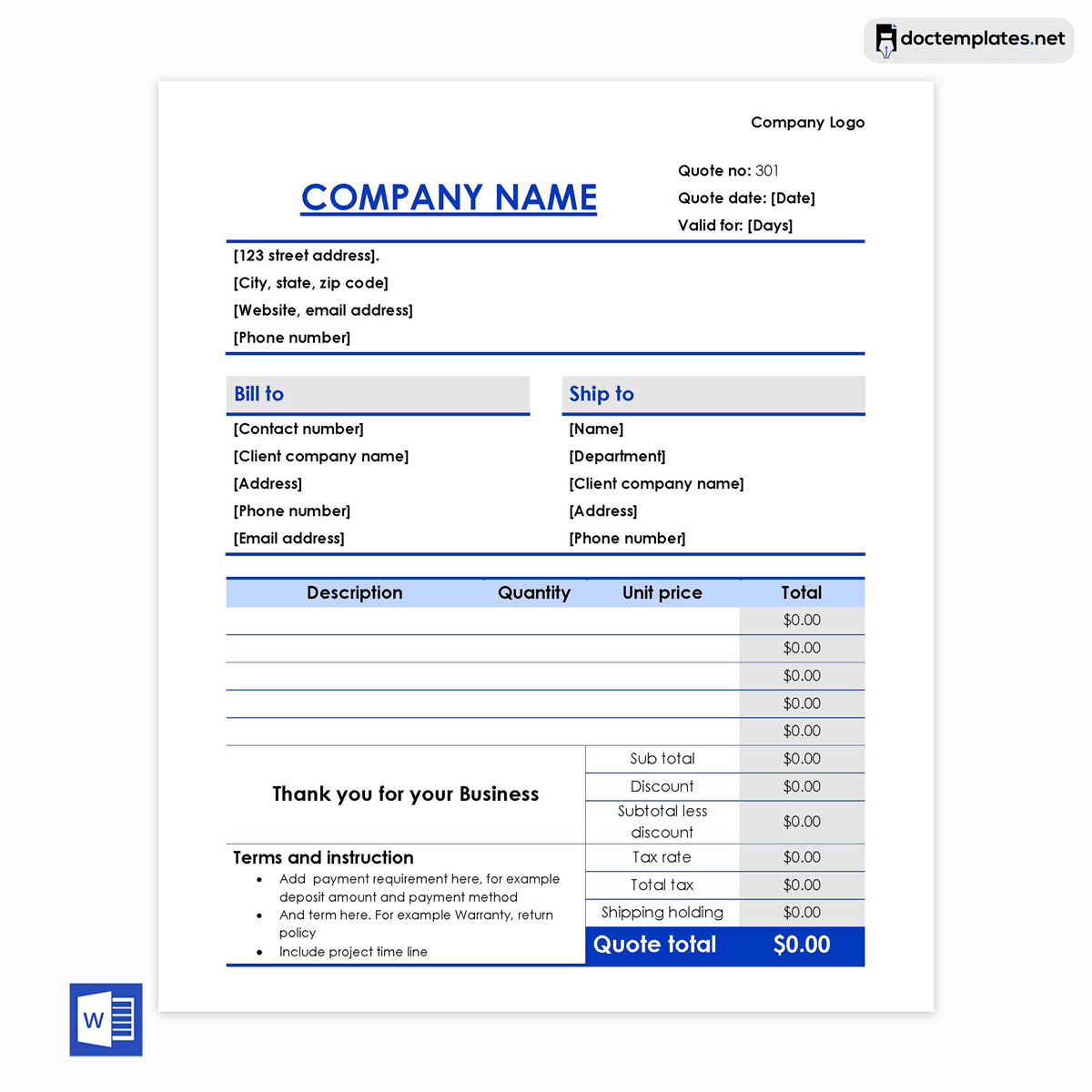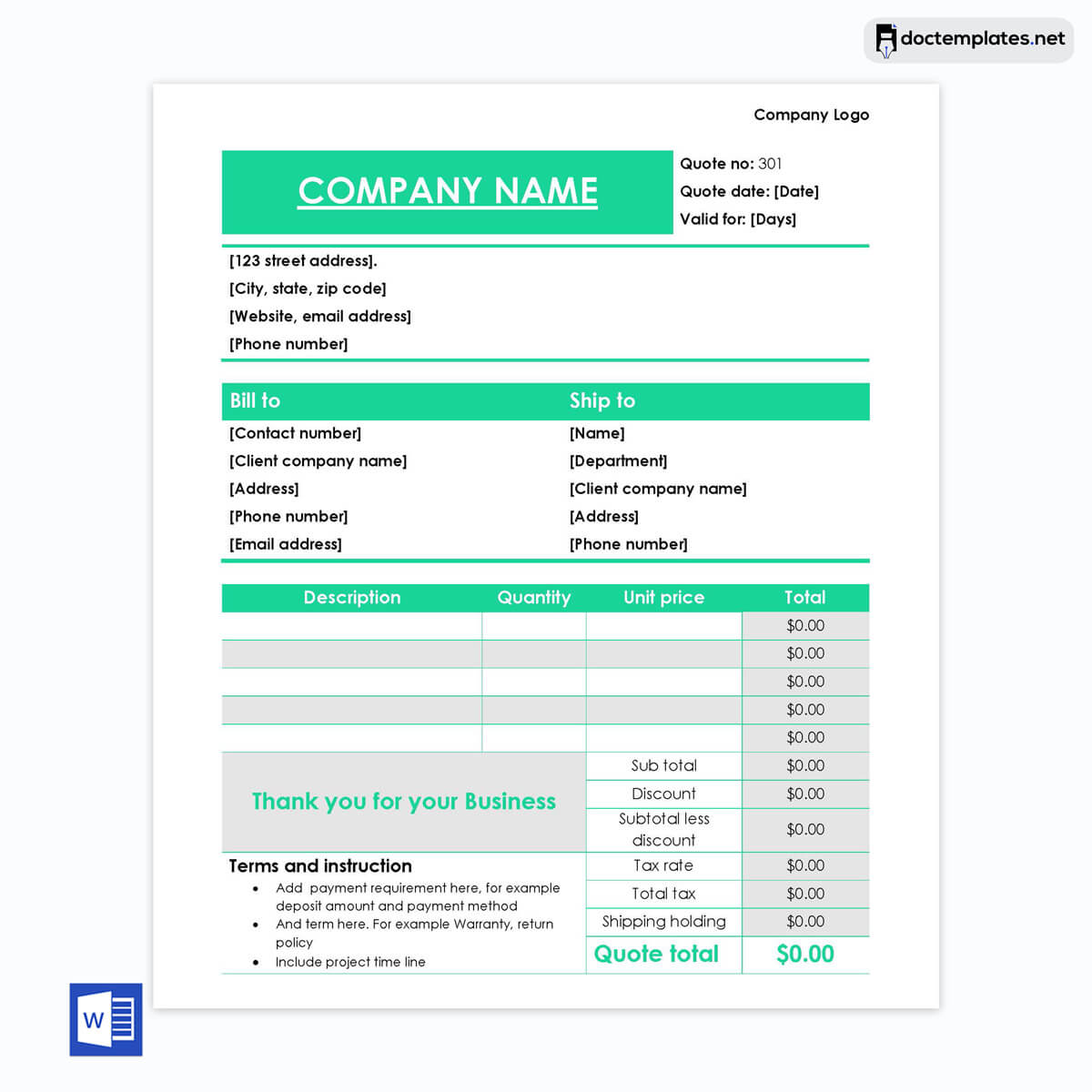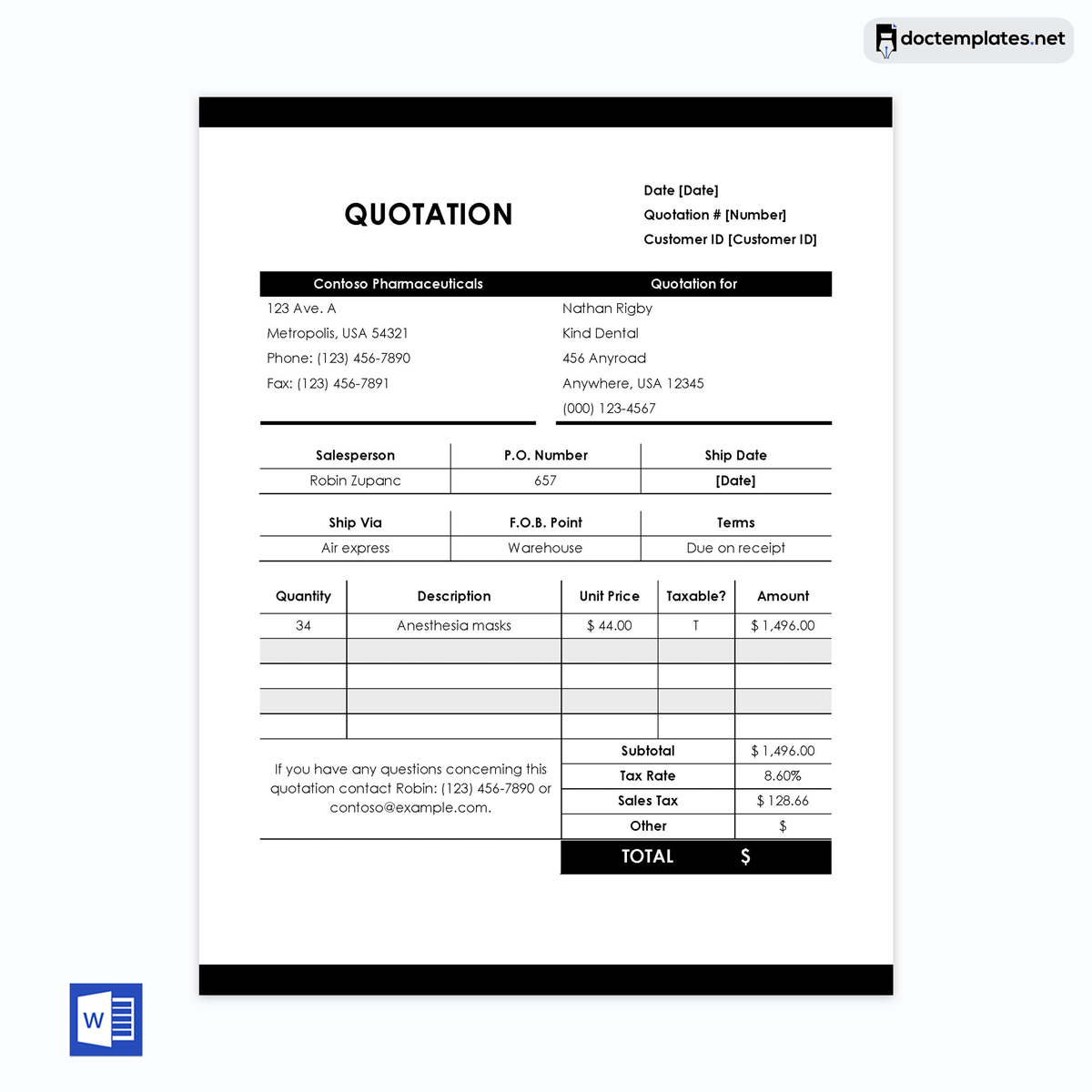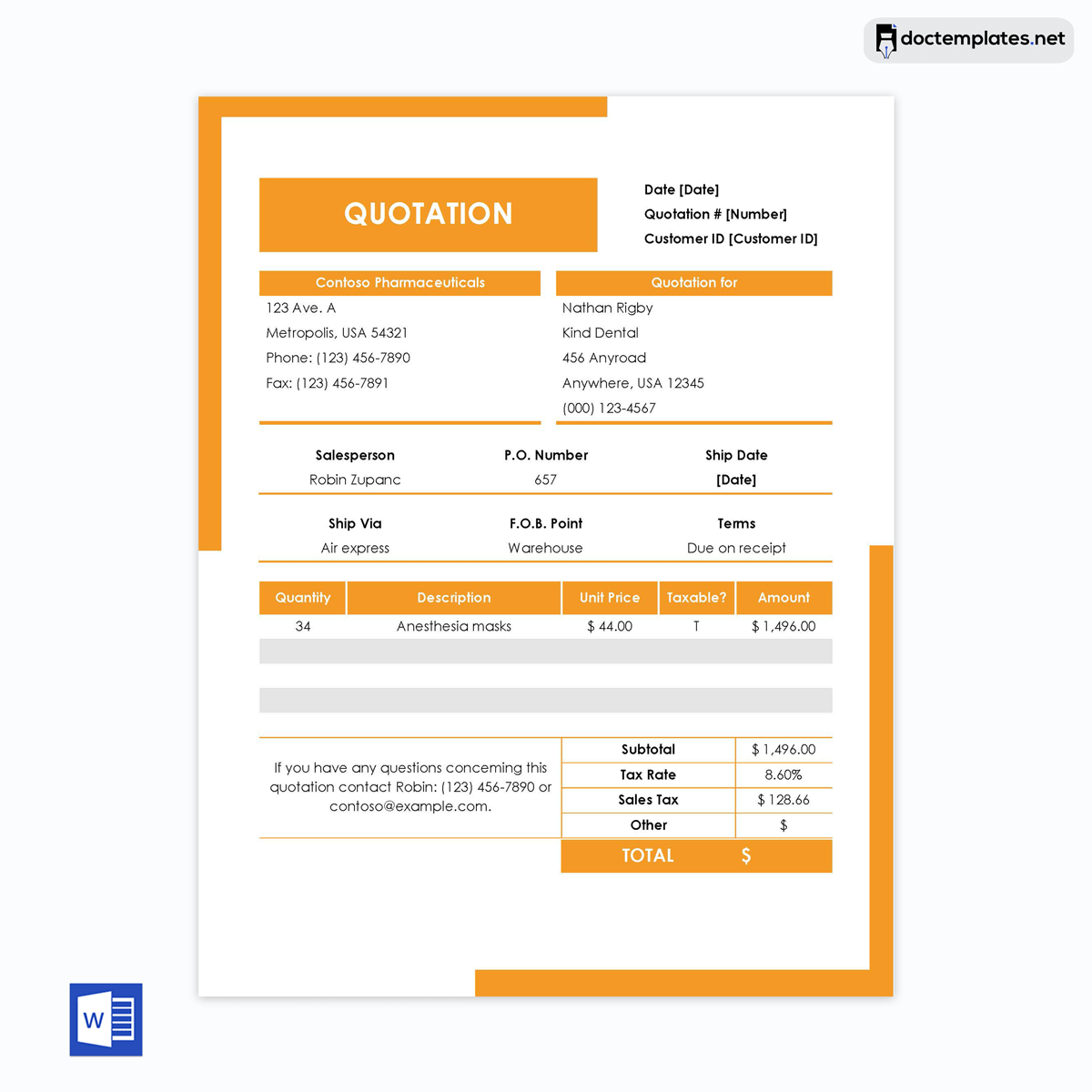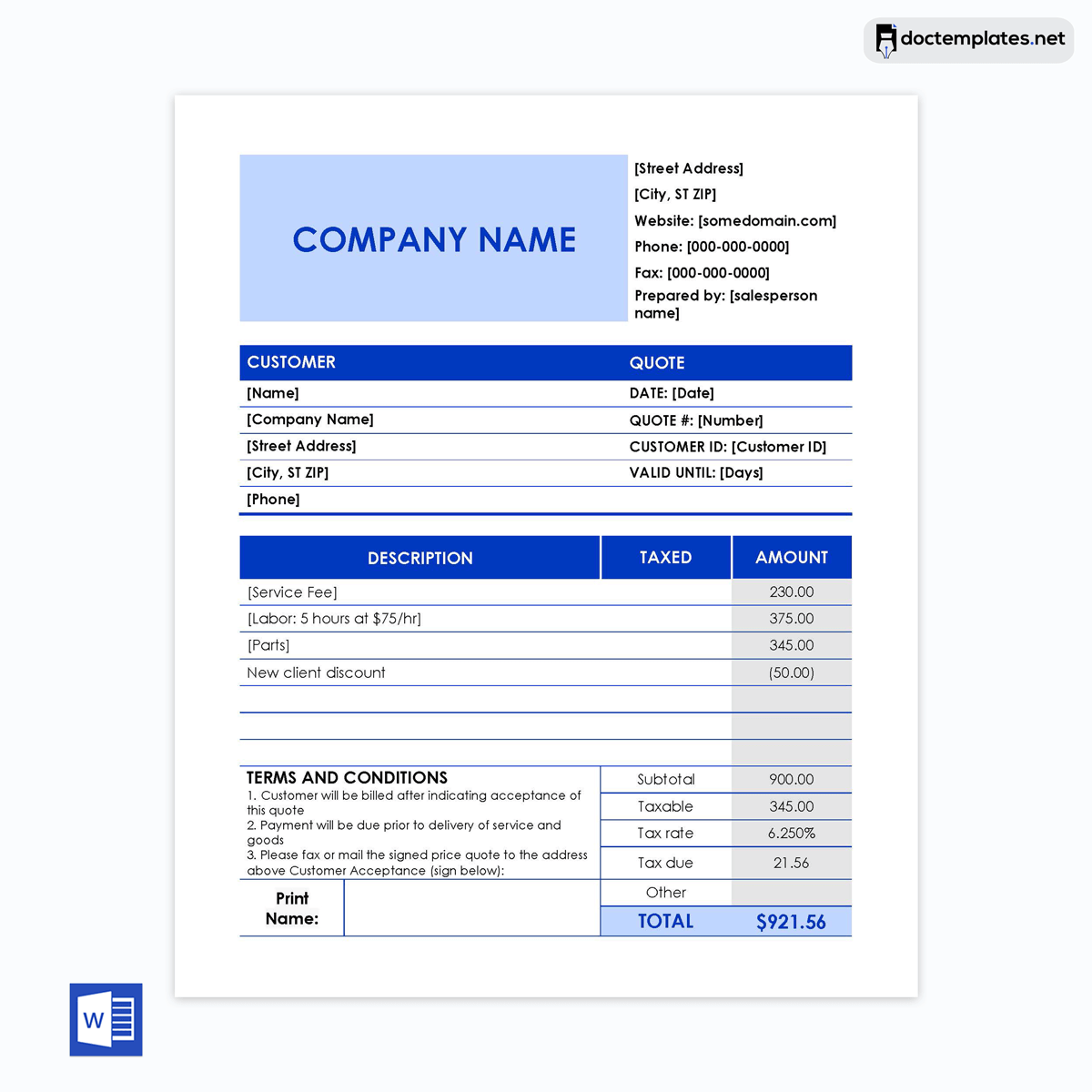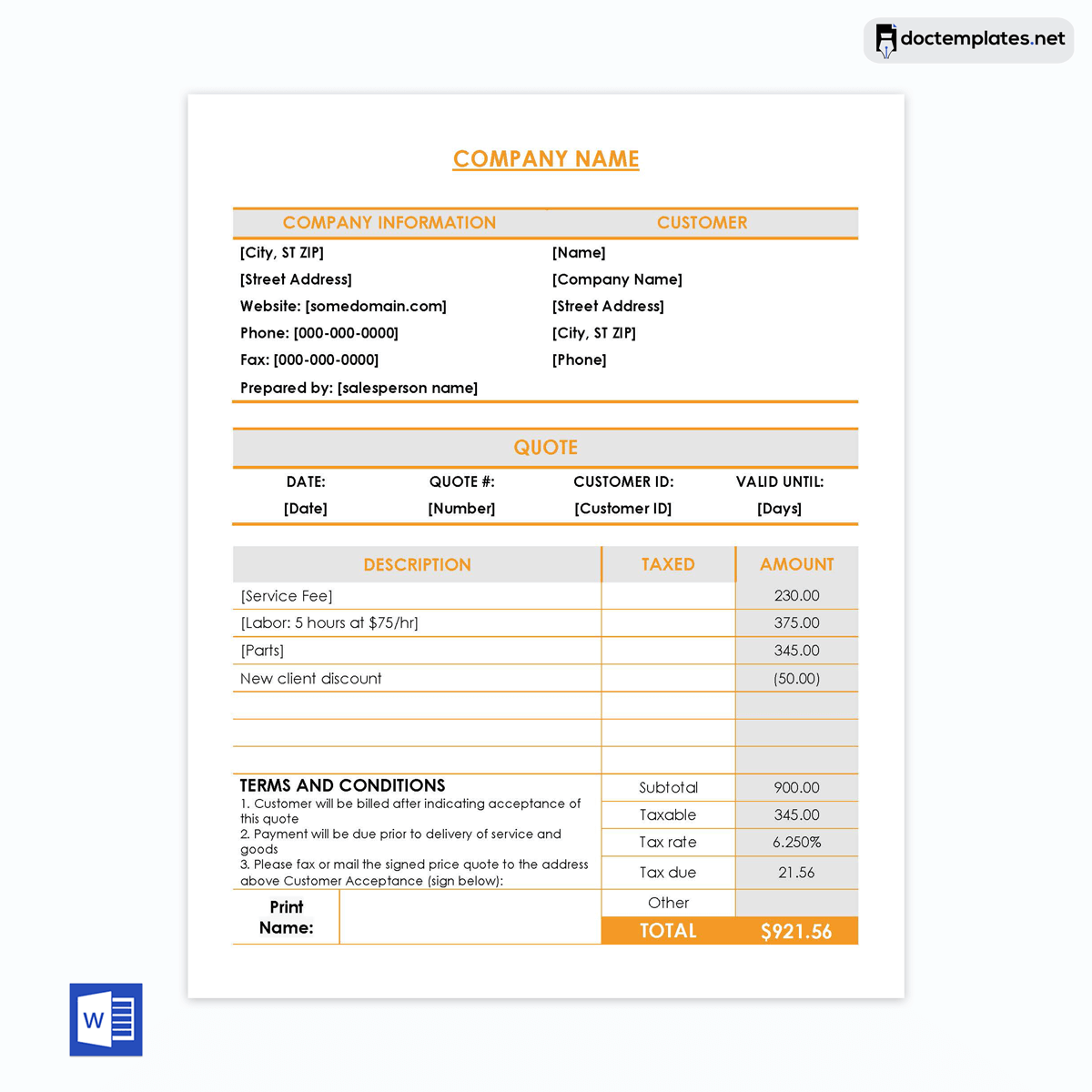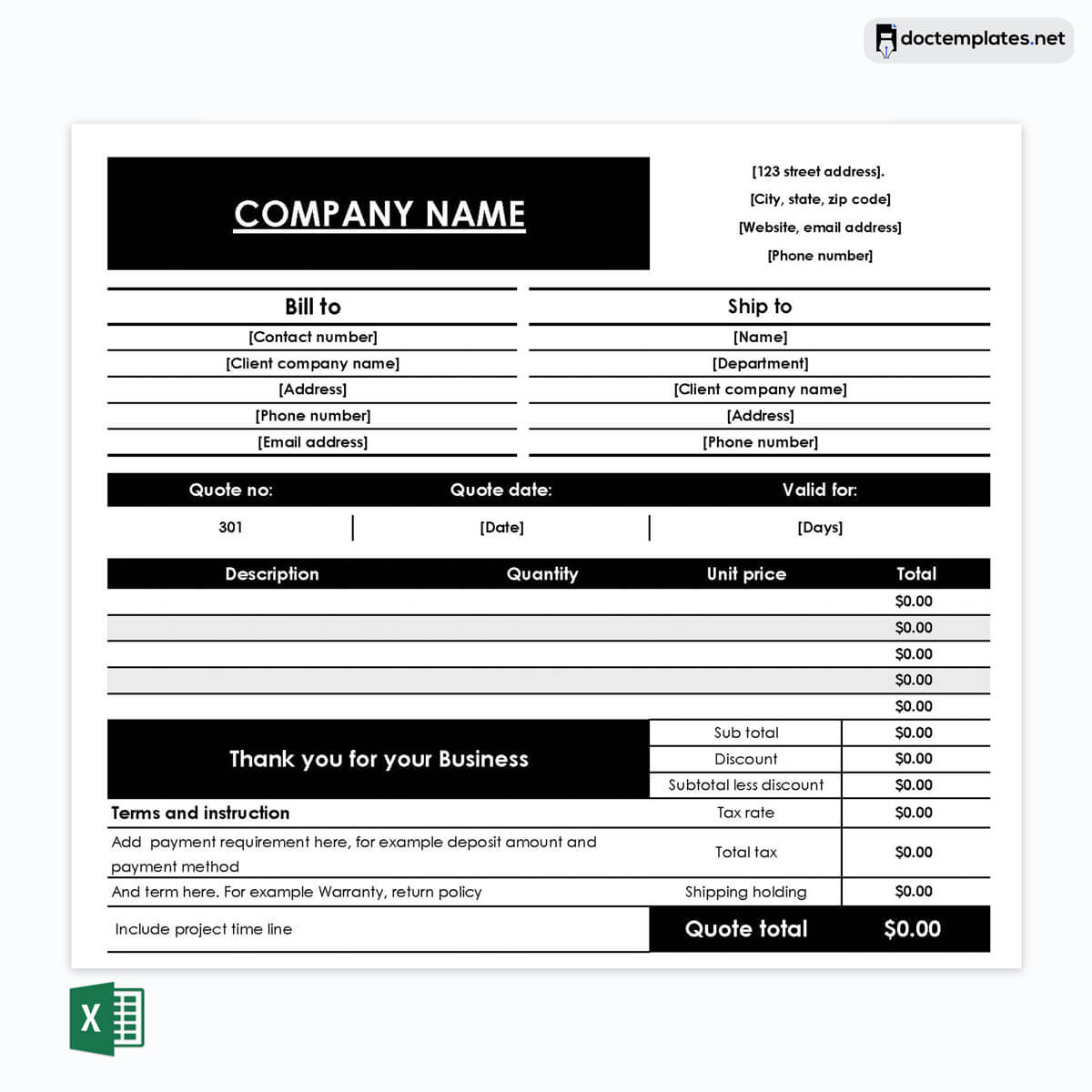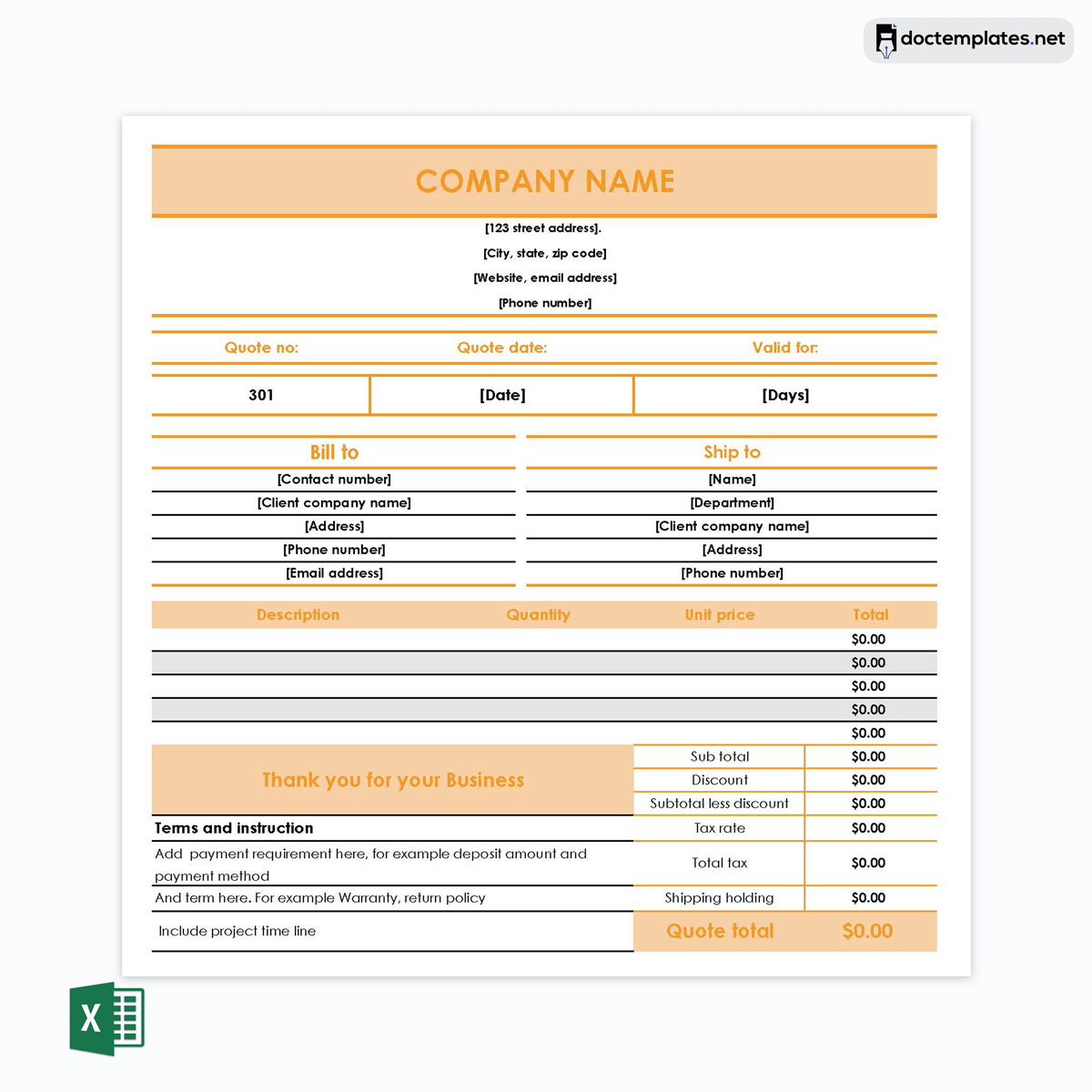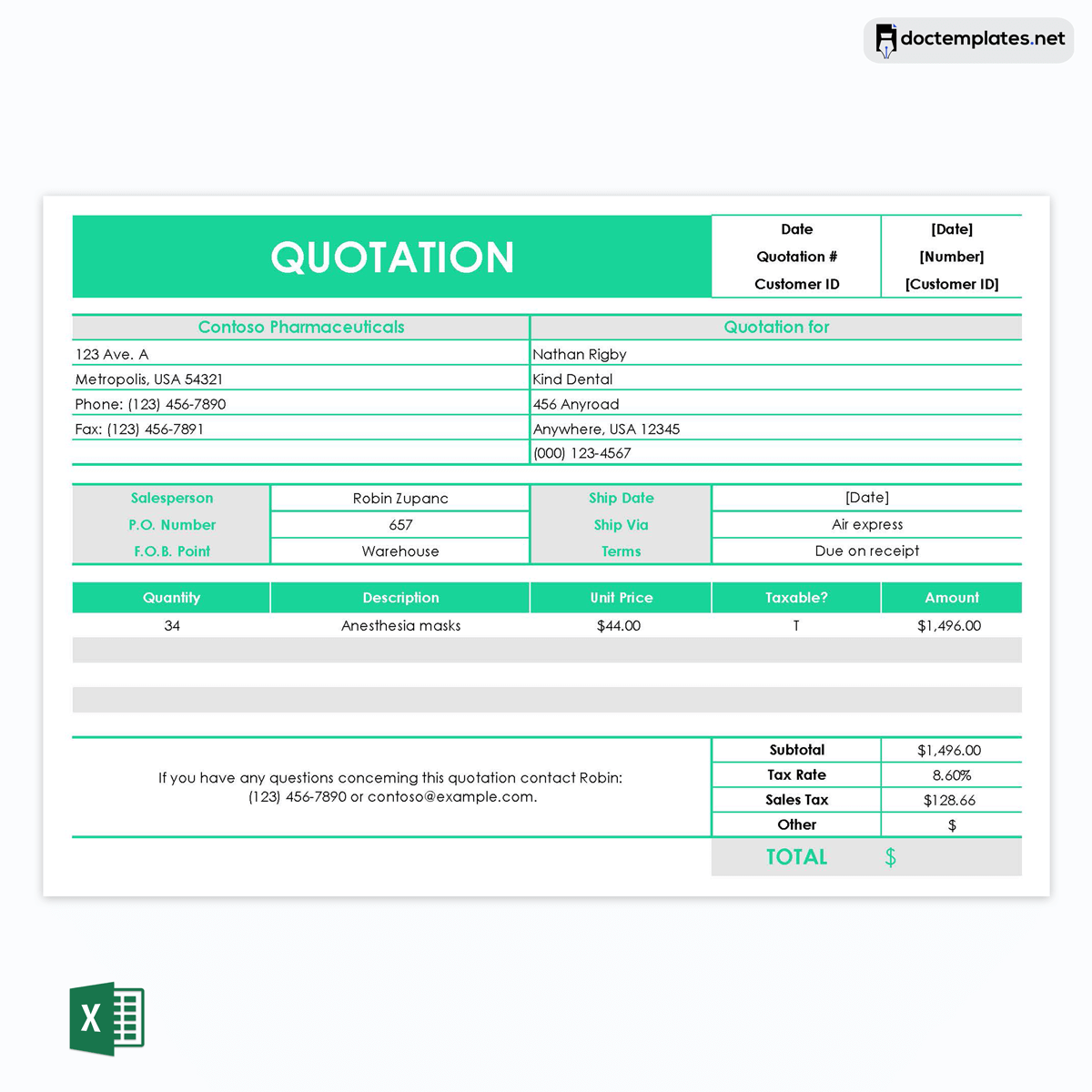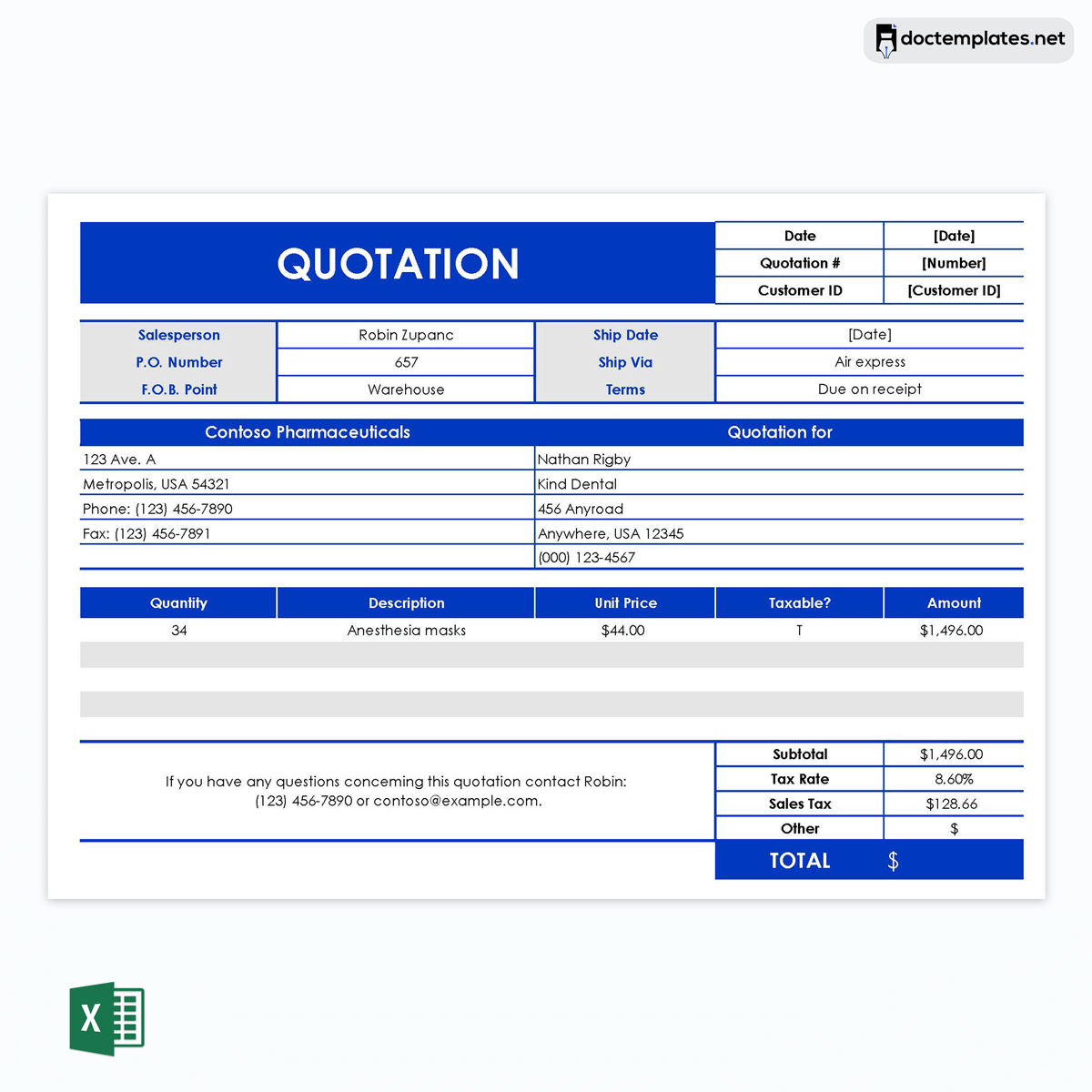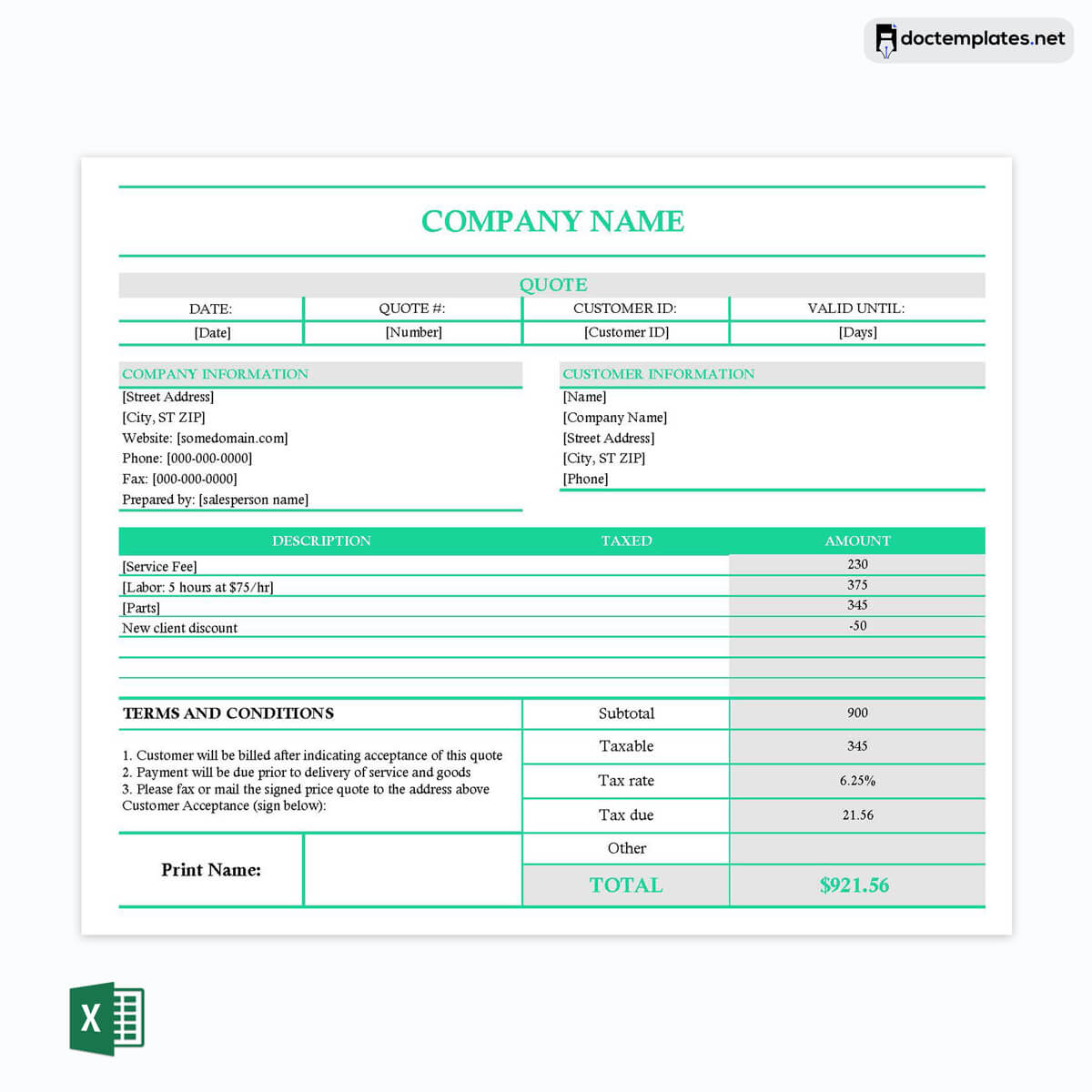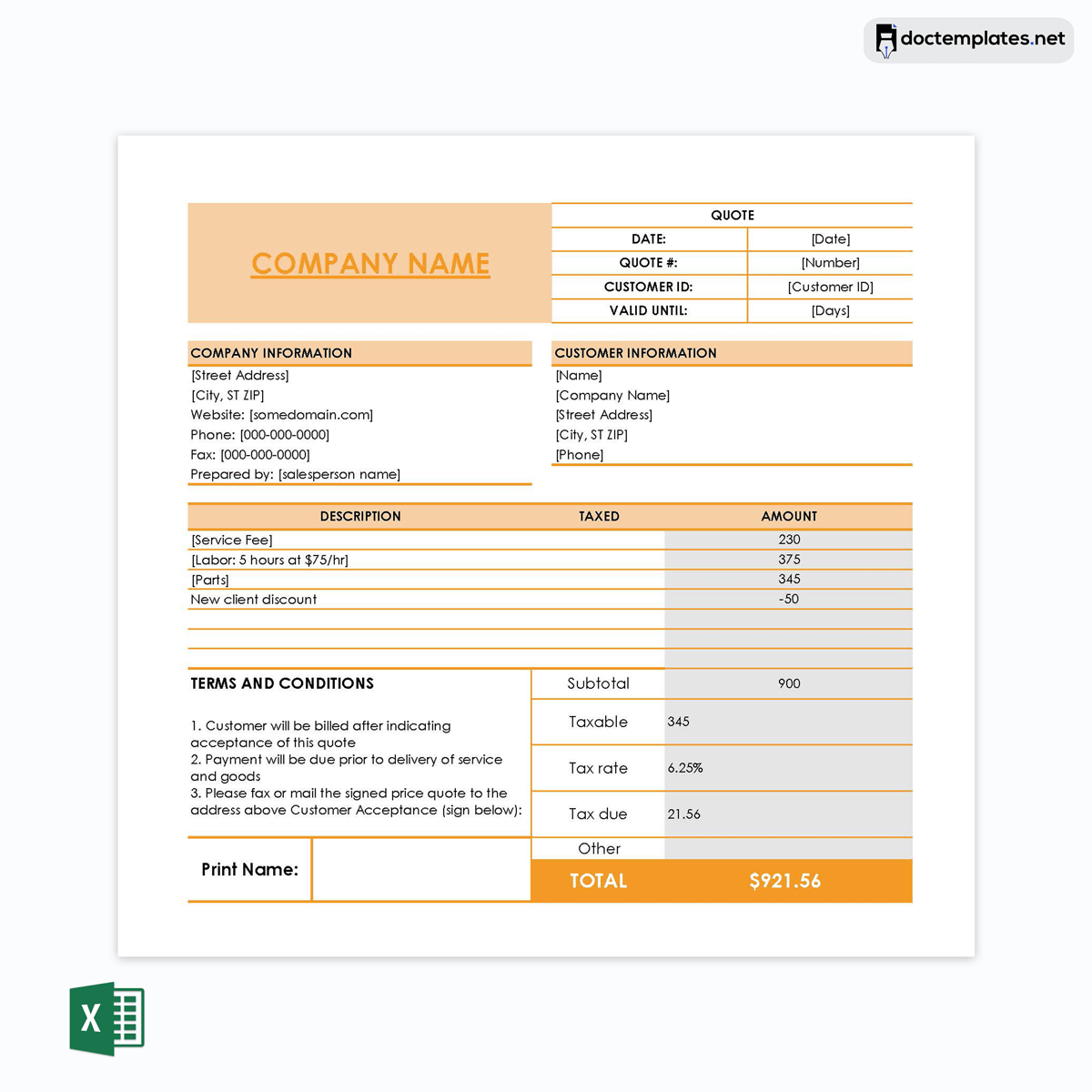A quotation is an itemized summary of goods and services a vendor is willing to sell to a client at a predetermined price and under specified terms of sale.
It is sent to the prospective client before any services or goods have been transacted. A quotation is not legal unless it is part of a signed contract. However, once sent or accepted by the client, the party is considered to have acknowledged the stipulations of the quotation.
Alternative terms of a quotation are:
- Business quote
- Quote
- Sales quote or
- Sale quotation
Quotations are key documents in a business transaction, especially for companies that offer differently priced goods and services. Since the document is sent to prospective clients, it can be deemed an invitation to the customer to do business with the sender. However, it is important to consider the factors influencing a customer’s decision to work with a company. These include the timeline within which the quote is sent, competitive prices, presentability and professionalism of the quote, website, and marketing material.
Additionally, customers will pay attention to the seller’s reputation, online reviews and comments on social media, and the quality of their work. Businesses can use templates to create professional and presentable quotations for their target audience by using MS Word and Excel.
Download Quote Templates
Following are the business quote templates that you can download for free:
The Impact of Quotes on Your Business
Quotation is essential in any business. Since it is sent at the customer’s request, a quote acts as the first transactional correspondence between you and your client regarding a specific job. It is a communication tool meant to inform clients about the cost of specific goods and services they are interested in.
A quotation is needed in industries where commodity prices change frequently or rely on multiple circumstances. The quote outlines the prices of the goods and services at the current market conditions. Also, always send the quote in good time so that you can be certain of its accuracy.
A quote does not guarantee you will be selected to do the work because you have to compete with several other businesses to get the customer’s approval. So, take your time to create a detailed, accurate, and professional quotation. The quote should also be competitively priced as it increases your chances of securing the opportunity to sell to the client. A well-crafted quote can convert a prospective client to a paying customer. Since it can be time-consuming to prepare a quotation, consider using a template.
Due to the impacts of a quotation highlighted above, a business cannot properly function without one. Therefore, this article will provide a detailed guide on what should be part of your quote and how to format it when making it in Excel. It also outlines best practices when issuing quotations and how to save some money and time with the help of free templates.
How to Create a Business Quote Template in MS Excel
There are different ways to create quotations – by using online software or platforms such as Excel. Consult the client to learn what platforms they would prefer. This way, you can create a quotation that is compatible with the client’s systems. The platform should also simplify future communications. Also, choose a tool that will produce professional-looking templates. This creates a positive impression on your targeted customers.
Below is a complete instruction guide on how to craft self-made quotes in Excel:
Create an Excel workbook and set margins
The first step is creating a workbook with the appropriate margin sizes. To set the margins, click Page Layout>Margins and select “Customer Margins.” A page setup window will appear; set the left margins as follows – left 1.5, right 1, top and bottom 2.
To set the paper size, go to Page Layout>Size under the “Page Set up” tab and select A4.
Note: These units are in centimeters, but you can change them to your desired units by going to File>Options>Advanced>Display and changing Ruler Units.
Add the header section
Secondly, your template should have a header section comprising the quotation’s identification details. This information is needed for filing and reference purposes.
This information must appear in a quotation for the following reasons:
- Your company name – The company name is needed for identification purposes. Note that the client will likely receive multiple documents from other businesses. Hence, it is important to introduce your business through the quote.
- Quotation title – Business documents need to have identifiers. The client should know what type of correspondence your document is – a quotation.
- Quote number – A quote number is required for reference and filing purposes. Since you typically send multiple quotations, having unique numbers as identifiers are important to simplify future reference.
- Date – All formal documents must be dated; a business quote is no exception. Dates are important for keeping track of when you send the document.
- PO number – You can include the purchase order to indicate the order for which the customer wanted a quotation.
- Terms – The terms are days when the quote is due to be invalid after being issued. The terms are needed to prevent customers from accepting the quote after a long time, yet commodity prices may have changed.
To include this information in your template, go to the first column A, row 1, and type “Your Company Name.” Select the columns from A1-F1, go to the alignment tab>Merge & Center, select the drop-down arrow, and select “Merge Across.” You can change the font to your preferred font and increase the font size.
Then, go to H1 and type the “Quote” or “Quotation.” Go to Format Cells>Border, and click “OK” to add a border underneath the selection.
Next, reduce the column A width to 3 centimeters. Proceed to B3 and add the Quotation Number, then add the PO Number, Date, and Terms (Days) in the subsequent rows (B4, B5, B6). Also, increase the width of column B to 13.78. You can add the automatic date functionality – Go to the date cell and type “=TODAY(),” and Excel will automatically input the day’s date.
Also, a drop-down list for your terms (days) can be added. Place the cursor in the cell you are to input the days, go to Data>Data Validation, and in the pop-up window, in the “Allow” section, select “List.” Add the applicable days in the source section using commas in between the numbers – for example, 30, 60, 90 and click “OK.” A drop-down will be added to the Terms sections. You can add also add color to distinguish your selection, as shown.
Then add a section for the logo.
Input the customer’s details
The third step involves the addition of a placeholder for the client’s details. In B8, type “quotation To.” Then, select columns B, C, and D from rows 9-16 and add borders using Format Cells. To add a drop-down list of your potential customers – First, create a new sheet and create a list with the customer names, addresses, and contact details. You can then rename the table, e.g., Cust_list. To add a drop-down list, go to the quotation template, select the respective customer name cell, and go to Data>Data Validation>Allow.
To add your customer names to the list, place the cursor in the source section, go to the customer list, and select the cells with the customer names.
Note: You can remove the gridlines to see how your quotation template is taking shape. Go to Page Layout, under Sheet Options, and uncheck the “View” checkbox under Gridlines.
An itemized list of billed items
After finalizing the header section, add a section to record the items you quote to the customer.
Details to be recorded in this section are:
- Product description- It is needed to record information such as item type, brand, model, and other descriptive information to help the client know what you are offering.
- Quantity of the products- The quantity indicates the number of goods or hours of service you offer for the quoted price.
- Price- This section records the unit price of each product.
- VAT- VAT has to be recorded to show how much of the quoted amount is due to tax.
- Subtotal- The total section records the cost of the goods or services without tax.
Go to B18 and type Description. Select B18-E18 and Merge Across. The add Quantity to F18, Price to G18, VAT to H18, and Total to I18. Adjust the width sizes of the columns in relation to the information they will hold – E to 9.56, F to 4, G to 9.56, H to 8.33, and I to 14.33.
Then, set the numbers under Price, VAT, and Total as currency. Select the respective columns, go to the number tab, select Currency in the dropdown menu, and choose the appropriate currency ($ English (United States)). Also, ensure that the text in the description section has the same font by selecting the entire section and the preferred font. You can input dummy items and prices to test if the template is functional.
Add formulas in the VAT and Total sections. For VAT, input =[select price cell]*20%. Then, copy the formula to the cells beneath. For the Total section, input =[select quantity cell]*[select price cell]. Copy the formula to the cells beneath.
This section will appear as follows:
Tip: To eliminate the zeros, modify the formula in VAT to be =IF(F19<>””,G19*20%,” “) and copy this formula to the rest of the cells. Use the same formula for the Total section, input = =IF(F19<>””,F19*G19,” “) and copy to the rest of the cells.
Add the subtotals and totals sections
Next, include a section of subtotals and totals in your template. This section is essential for summarizing your quotation and calculating the amount associated with the goods or services. Select G38-I38 and fill it with your preferred color. Then add the subtotal, VAT, and Total in column G from 39-41.
In the subtotals section, input the formula =SUM(I19:I35) – the summation of totals of the billed items. In the VAT section, input =SUM(H19:H35). In the total amount, input =SUM(H39,H40) – the sum of subtotal and VAT.
Add a custom message area
Afterward, add an area to input a message to your clients. Go to B37, type “Customer Message,” select B37 to E37, and add a bottom border. Then, select columns B-E from rows 38-41 and add side and bottom borders.
Insert company details and payment details section
Afterward, add a section to include your company details and payment details. The company details are meant as identification details and authenticate the quotation further. You can include business numbers, VAT registration numbers, and phone numbers. To add these sections, go to B43 and type “Company Details.” Beneath the company details, indicate the Company No, VAT No, email, and Telephone number.
The payment details are meant to facilitate payment. Such details include account number, bank, sort code, and IBAN (for international clients). Then, go to G43 to type “Payment Details’ and type Account number, bank, sort code, and IBAN in the subsequent rows. Select the entire row 43, choose an appropriate font, and fill it with a color to highlight this section.
Add formulas and functionality
In the next step, you can add the different formulas and functionalities to make your template more useful when preparing quotations, as shown.
You can add formulas to enable the template to collect information from your customer list. Go to the cell beneath the customer name and type =VLOOKUP, and select the customer name cell (B9). Then, in the formula, add the table array or name, which is Cust_list, and the column of the first address (2) as follows; =VLOOKUP(B9,cust_list,2,0). The cell will display the customer’s first address. To add the same formula to the other cells beneath, first fix the reference to B9 such that the command is as follows – =VLOOKUP($B$9, Cust_list,2,0).
Then, copy the command to the other cells. Then, adjust the column reference accordingly – for example, =VLOOKUP(B9,cust_list,3,0), =VLOOKUP(B9,cust_list,4,0). After this, whenever you select a customer name in the drop-down list, their addresses will appear in the template.
Save the document
Lastly, preview the document, edit accordingly, and save. Try to print it and visualize how it will appear when printed. You can then save the file as a PDF by going to File>Export, then create the PDF.
Templates can save you time and effort in creating a business quotation from scratch. They serve as a guide to direct you on what information to input in your quote and where to place this information. Since creating it can be time-consuming, you can use free and ready-made templates. Such templates have been provided in this article.
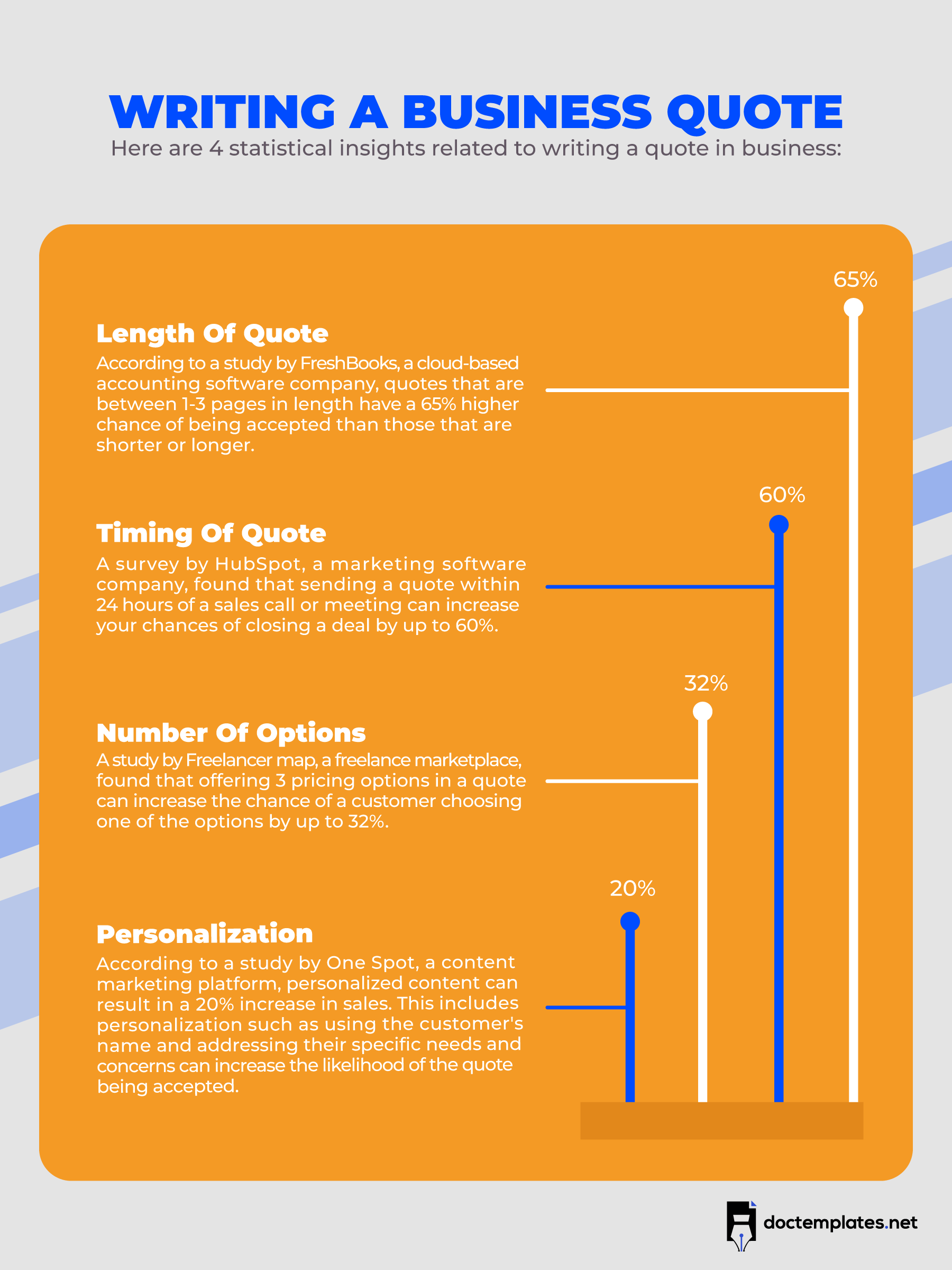
5 Tips to Consider While Writing a Quotation
A well-presented quote will turn conversions into sales. To write a winning quotation for a prospective customer, here are five tips you should consider during the creation process:
Present it professionally
A professional quotation is more persuasive and can instill trust in the client. So, make your business quote more professional by using a letterhead, proofreading for errors, and formatting the document appropriately. Also, type the quote instead of handwriting it.
Add value and offer attractive options
You should not target sending a quote that offers the cheapest option but rather the most valuable one. You can provide alternative purchases the client may choose from or incentives that make your business the most valuable option.
Allow a buffer of time and specify additional costs
When preparing a quotation for a service, account for time related to contingencies and additional costs. These costs can be calculated as 15% of the cost of the job.
Use a professional format
The components of the quotation should be well organized. So, use a formal layout and font. You can personalize the quotation by adding colors that reflect your brand or company logo. Do not go overboard with the customization; keep it simple, as it has to be legible.
Revise your quote
Should the client change the job’s specifications, revise your quotation and resend it. It is imperative to prioritize customer expectations over your business objectives.
Frequently Asked Questions
What tips should one follow while quoting in business?
Your quotation should prioritize the customer’s needs. So, check stock before sending a quote. Also, ensure you or your suppliers can provide the products the customer wants within the stipulated timeframe before issuing the quote. Your business quotes should be in writing, ideally typed for professionalism. You should follow up after issuing a quotation. This illustrates your interest in working with the client. Before starting the job, always identify the associated risks and plan how to mitigate them.
Are quotations in legal business binding?
Though not legally binding at the time of issuance, a quotation can be legally enforceable should the client accept your proposition. So, it is advisable to label the document correctly. You can label the document as Estimates to eliminate the legal component of quotes.
Can you use quotations in business as an invoice?
It is advisable not to use a quotation in place of an invoice. A quotation is sent before work is begun. Therefore, the quoted price can change as the scope of the work changes, often as per the customer’s request. On the other hand, an invoice is sent after work has been completed. The invoice will include all the initially agreed prices and any additional costs incurred as work was done. Also, the accounting department recognizes quotations and invoices as two separate documents.
